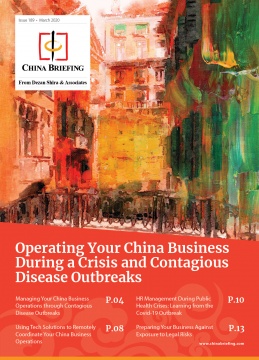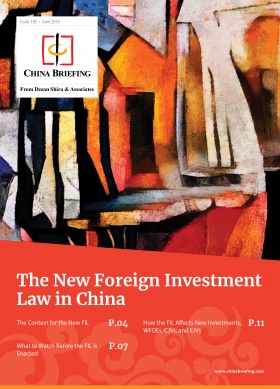The Social and Economic Impact of COVID-19 on China and its Recovery Potential
Current situation
As the first country to be engulfed in the COVID-19 pandemic, China is several weeks ahead of many other countries on the “curve” of the virus progression. As such, the changing situation in China is being monitored closely by many other countries. While statistical methods of counting infections and deaths have differed across countries, it is generally agreed that China has the pandemic largely under control at the current stage, with increases in new cases rising at a rate of less than 100 per day (although there was a spike to 108 on Sunday, April 12). Of course there is some concern that asymptomatic cases are not being identified effectively, but the fact that the number of new symptomatic cases is low (therefore the hospitals are not overwhelmed) is acting as a kind of proxy to provide confidence to the wider population that the situation has improved dramatically.
Indeed, in China, the public mood moved on from one of fear to one of caution around late February. Since then, while many restrictions remain in place around the country, caution has morphed into mere habit. Having worn a facemask every day for close to three months now, I feel slightly naked in public without one. People are adjusting to the “new normal” and seem to realize that there is a long battle ahead. While they realize it is going to be tough, there is a general sense among the population that China will be able to manage the adaptation process more effectively than most governments around the world.
The government response ramped up quickly after January 23, and restrictions became more and more onerous through February and most of March. Access to residential compounds was banned to people not registered as living within them. Restaurants closed for around 2.5 months, only recently re-opening. Much domestic travel required quarantine upon arrival at destination for 14 days, and a similar policy was introduced for international travel once the pandemic was confirmed as a global problem. Right now, even foreigners with valid visas and working permits are not allowed back into China. The concern now is focused on Chinese nationals returning to China from Europe and America. The draconian measures the government is implementing to take such people directly from airports to quarantine facilities shows how seriously the government is taking these potential “imported” coronavirus cases. Of the 99 new cases reported on April 11 across China, 97 were “imported”, according to Reuters.
Economic impact
Meanwhile, confidence in the government response seems high. Nevertheless, businesspeople realize that many types of business are being seriously hit. Food and beverage, retail, real estate, and travel are the four biggest losers. A lot of people in these sectors have either been furloughed for a period of time or have lost their jobs completely. Migrant workers in the construction sector are hugely impacted. Many of these jobs don’t show up in official government figures, so while there has been a significant uptick in the unemployment rate, it is likely that the real figure is much higher. A lot of lower-earning individuals will be suffering for a prolonged period of time.
Compared with other countries, the support measures that the government has put in place have been relatively limited. The most relevant benefit to businesses has been the partial waiving of the social security contribution made by employers on behalf of staff between the period of February to June. There are other programs in place as well, but most of them require the companies applying to be involved in the effort to combat the virus spread. Loans have also been relatively difficult for many Chinese companies to obtain. The bankruptcy of many companies and major problems for account receivable collection for those that remain standing seems inevitable.
Potential recovery
At the moment certain sectors of the economy are recovering. But not quickly. Malls are open, but sparsely populated. Restaurants are open, but with very few customers. There seems to still be a kind of reluctance among people to go out and enjoy themselves, perhaps worried about opprobrium from the many that are still struggling financially or that they will be accused of potentially spreading the virus. Habits may well have changed permanently. Unsurprisingly, people are reluctant to spend large amounts of money on cars, houses etc. because of the overall uncertainty.
Certain sectors are definitely booming. This will be a worldwide phenomenon, and it in fact may play into the hands of China in the medium term. It is well-known that China is ahead in the “race to 5G”, which is all about “digital” and “remote”. During this pandemic, China probably pulled further ahead. Online teaching and conferencing have boomed. Delivery of goods rather than visiting shops has continued its transition to the mainstream. The economy has taken another step towards modernization.
A lot of the companies that have benefited from that shift will presumably be flush with cash, and keen to invest it overseas going forwards considering the knowledge and technology they have accumulated already in China.
One particular overall impression that I have been left with is that rather than “living”, people in China are choosing to just “exist” for a while. This may be easier for the Chinese population, many of whom remember the tough times before the opening up of the economy in the 1980s and 1990s, compared with the baby-boomers and younger generations in the west who, in the eyes of the Chinese, have been living decadent lives since the 1950s. Nevertheless, this attitude will have severe repercussions for the economy as a whole. To what extent the Chinese government opts to encourage the return of a bit of that decadence that certainly existed in the last several years in China may have a big effect on the medium-term economic impact in the country.
Adam Livermore is a Partner with Dezan Shira & Associates in Dalian, China. He may be contacted at adam.livermore@dezshira.com.
This article has been extracted from a larger report concerning the Impact of COVID-19 on the BRICS economies of Brazil, Russia, India, China, and South Africa, published on Silk Road Briefing on April 12. To read the complete report please click here.
Related Reading
-
- COVID-19: Which IT Systems to Deploy to Assist Employees Working from Home
- China’s Support Policies for Businesses Under COVID-19: A Comprehensive List
 Operating Your China Business During a Crisis and Contagious Disease Outbreaks
Operating Your China Business During a Crisis and Contagious Disease Outbreaks
In this special edition of China Briefing magazine, we identify key concerns for business managers during infectious disease outbreaks, including managing a remote workforce, using IT solutions to navigate business operations more efficiently and securely, and addressing the legal risks in case contractual obligations are not satisfied.
About Us
China Briefing is written and produced by Dezan Shira & Associates. The practice assists foreign investors into China and has done since 1992 through offices in Beijing, Tianjin, Dalian, Qingdao, Shanghai, Hangzhou, Ningbo, Suzhou, Guangzhou, Dongguan, Zhongshan, Shenzhen, and Hong Kong. Please contact the firm for assistance in China at china@dezshira.com.
We also maintain offices assisting foreign investors in Vietnam, Indonesia, Singapore, The Philippines, Malaysia, and Thailand in addition to our practices in India and Russia and our trade research facilities along the Belt & Road Initiative.
- Previous Article Come in Cina il Covid19 trasformerà il Settore degli alimenti freschi
- Next Article Hong Kong Unveils Anti-Epidemic Fund 2.0: Support for Businesses, Job Retention






